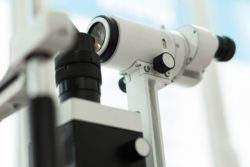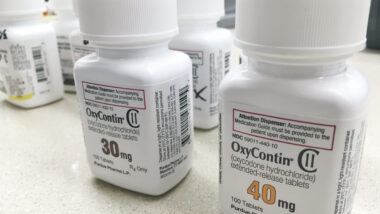Top Class Actions’s website and social media posts use affiliate links. If you make a purchase using such links, we may receive a commission, but it will not result in any additional charges to you. Please review our Affiliate Link Disclosure for more information.
Macular degeneration is a condition that can gradually cause your vision to blur over time. This condition is the top cause of vision loss among older people in the United States, affects from a quarter to a third of all people over the age of 75, and is, in some cases, one of the potential side effects of Elmiron. There is no cure for this condition, but treatment for macular degeneration is available and ranges from supplements to laser procedures depending on the severity of the case.
What Is Macular Degeneration?
Macular degeneration comes in two levels of severity: dry and wet. Dry macular degeneration is the most common and less severe version, affecting roughly 85% of all macular degeneration patients. Dry macular degeneration is caused by an accumulation of proteins in the eye. The proteins accumulate in the macula, and this causes the retinal cells above not to function properly. Protein deposits of this kind are called drusen. Dry macular degeneration is usually painless and involves a slow loss of vision.
Wet macular degeneration is caused by leaks in the blood vessels in the retina. These vessels may leak either blood or other fluids into the back of the eye. Wet macular degeneration is likely to cause more significant vision loss than its dry counterpart. This version of the condition is sometimes associated with more sudden vision loss.
Treatment of macular degeneration varies depending on whether you have wet or dry degeneration.
Is Macular Degeneration Hereditary?
While macular degeneration is most commonly associated with aging, there may also be a genetic component. Research on this topic has shown a strong link between macular degeneration and the presence of a variant gene. Another contributing factor may be exposure to sunlight, though this theory has yet to be proven. Factors that may put you at greater risk of developing macular degeneration include obesity, smoking, cardiovascular disease, aging, and a history of the condition in your family.
While a hereditary history of the condition may be a sign that you are more likely to develop it as well, the National Institutes of Health (NIH) states that there isn’t a “clear-cut pattern of inheritance.” The NIH states that 15 to 20 percent of those with the condition have at least one “first-degree relative” who also has the condition.
Causes of Macular Degeneration
According to the Mayo Clinic, the exact cause of macular degeneration is unknown. As the eye ages, the condition is more likely to occur. Factors, such as diet and smoking, have been linked to the disease, as well as heredity factors.
The risk of developing either wet or dry macular degeneration increases with the following factors, says the Mayo Clinic, not all of which a person can control:
- Weight – those who are obese may be more likely to develop more severe cases of macular degeneration or risk early onset of the disease
- Smoking – Using cigarettes or being regularly exposed to smoke can increase the risk
- Cardiovascular disease – Those with a history of heart or blood vessel diseases are more likely to develop macular degeneration
Age and race can also play a part. The Mayo Clinic reports that those over 50 are at a higher risk of developing macular degeneration as are Caucasians.
Additionally, research has linked the use of Elmiron, a bladder drug, to the development of macular degeneration. According to the American Academy of Ophthalmology, after initial concerns about the link between the drug and condition were revealed, additional study supported the conclusion that Elmiron may play a part in the development of macular degeneration.
According to the report, the dosage of the medication may be a factor and more study is needed to determine safe levels. Researchers warned that, in late stages of the disease, stopping Elmiron may not reverse macular degeneration in a patient.
Macular Degeneration Signs to Look Out For
If you’re concerned that you may have macular degeneration, there are a few warning signs for which to watch. Early signs include shadowy areas in the center of your vision. Generally, fuzzy or distorted vision may also be a sign of the condition. This may result in trouble or discomfort reading due to wavy or distorted text. It’s possible that the condition may only appear in one eye, or it may be significantly more developed in one eye than the other. This can make it harder for some to notice the condition; viewing with both eyes may make the symptoms less noticeable.
If you have experienced any of these symptoms, speak to your doctor. The sooner you are able to identify the condition, the more successful the treatment for macular degeneration usually is.
Treatment for Macular Degeneration

If you have dry macular degeneration, your options are limited. In fact, All About Vision reports that there are no Food and Drug Administration-approved treatments for dry macular degeneration. However, if you have this condition, your doctor may recommend you take nutritional supplements and antioxidants that can reduce the risk that your condition will develop into the more serious wet version.
If you have wet macular degeneration, the main goal of treatment is to slow or stop the actual effects of the condition. This means shrinking or stopping abnormal blood vessel growth as well as the prevention of leaks into the back of the eye. The first way to do this is with injections of drugs meant to stop the vessel growth, but additional medical and laser procedures may be needed. These laser procedures are often used to destroy abnormal blood vessels growing in the eye. Other types of laser procedures involve a combination of lasers and light-sensitive drugs.
For those suffering from this condition, magnifiers or phone apps that serve a similar purpose may make your life a little easier.
Injections for Macular Degeneration
The most common form of treatment for macular degeneration involves injections directly into the eye. These injections usually contain anti-angiogenic drugs. These drugs are intended to stop the formation of new blood vessels and to block any leaks from abnormal vessels. This treatment will likely require repeat follow-up visits and repeat injections. Some people who use injection treatment for macular degeneration have been able to regain the vision that they lost due to the condition.
According to the American Macular Degeneration Foundation (AMCF), recent developments in this form of treatment have allowed doctors to achieve the same effects with fewer repeat injections.
Can Elmiron Cause Macular Degeneration?
Interstitial cystitis drug Elmiron may induce a type of macular degeneration called pigmentary maculopathy. This condition is marked by a buildup of pentosan polysulfate sodium inside the cells of the retina and resemble tiny specks. Pentosan polysulfate sodium is the active ingredient in Elmiron.
One of the first doctors to notice the potential link between Elmiron and pigmentary maculopathy was Dr. Nieraj Jain, MD. He found that a number of his patients who had been taking Elmiron for an average of 16 years appeared to have the same pattern of visual disturbances that took around 10 years to become noticeable. He told the American Academy of Ophthalmology in 2018 that views of the fundus might not as clearly show the issues in the eye as much as advanced retinal imaging can reveal.
In an article in the Ophthalmology medical journal published in May 2018 and written by Dr. Jain, along with William A. Pearce, MD and Rui Chen, PhD, the doctors write, “We describe a novel and possibly avoidable maculopathy associated with chronic exposure to PPS. Patients reported symptoms of difficulty reading and prolonged dark adaptation despite generally intact visual acuity and subtle funduscopic findings.”
Pigmentary macular degeneration (pigmentary maculopathy) appears to be unique to those patients who have been on Elmiron for multiple years. The doctors who authored the study said that further investigation may determine why the medication could cause such a visual disturbance. Treatment for macular degeneration of this type may include stopping Elmiron.
Breakthroughs in Treatment for Macular Degeneration
In 2014, the American Foundation for the Blind announced the introduction of three new techniques and forms of treatment for macular degeneration.
The first technique involves detecting the condition earlier in order to halt its progression sooner. The AdaptDx Dark Adaptometer is a tool that can be used by doctors to detect the early signs of macular degeneration. The adaptometer tests a person’s ability to detect light and involves pressing a button when you see an increasingly faint dot of light. This test functions similarly to your standard hearing test, and it can help doctors spot macular degeneration sooner.
Next, the Foundation describes two new breakthroughs in the treatment of wet macular degeneration. First, the IRay Radiotherapy System utilizes radiation to stop the growth of abnormal blood vessels in a similar way to how radiation is used to stop cancer growth. However, using radiation on a person’s eye poses certain risks: the eye must remain still, and the brain behind the eye must be protected from radiation. To solve these problems, this treatment utilizes a special contact lens and uses a weak beam of radiation for a longer period of time.
The third breakthrough in the treatment for macular degeneration comes in the form of another radiation-based therapy. This second treatment uses a handheld ophthalmic device in order to place a therapeutic radioisotope as close to the problem area as possible. For this treatment, a doctor uses a powerful fiber optic light to guide the positioning of a tiny amount of radioactive strontium 90.
ATTORNEY ADVERTISING
Top Class Actions is a Proud Member of the American Bar Association
LEGAL INFORMATION IS NOT LEGAL ADVICE
Top Class Actions Legal Statement
©2008 – 2024 Top Class Actions® LLC
Various Trademarks held by their respective owners
This website is not intended for viewing or usage by European Union citizens.
Get Help – It’s Free
Join a Free Elmiron Lawsuit Investigation
If you qualify, an attorney will contact you to discuss the details of your potential case at no charge to you.
PLEASE NOTE: If you want to participate in this investigation, it is imperative that you reply to the law firm if they call or email you. Failing to do so may result in you not getting signed up as a client or getting you dropped as a client.
E-mail any problems with this form to:
Questions@TopClassActions.com.
Oops! We could not locate your form.













